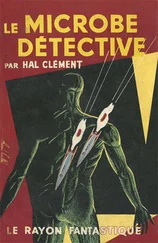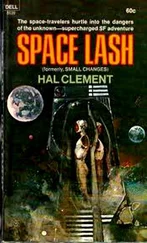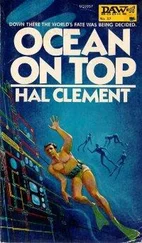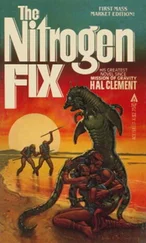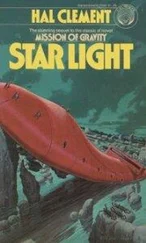It was a seat, identical to the one in the contro chamber — a mound of metal, with five deep groove; equally spaced around it. The tiny reflected images of th(flashlights stared up from its convex surfaces like lumi nous eyes. None of the other furniture that had character ized the room in the central bow corridor was present but the floor was not quite bare.
Opposite each of the five grooves in the seat, perhaps foot out from it, a yard-long metal cable was neatl! welded to the floor. A little farther out, and also equall! spaced about the seat, were three more almost twice a long. The free end of each of the eight cables was cut of cleanly, as though by some extremely efficient instrument the flat cut surfaces were almost mirrorsmooth.
Stevensoi and Preble examined them carefully, and then looked a each other with thoughtful expressions. Both were begin ring to get ideas. Neither was willing to divulge them.
There remained to explore only the stern engine roon and the passage leading to it, together with the room; along the latter. They had no tools with which to remove a specimen of one of the cables, so they carefully notes the door behind which the seat and its surroundings has been found, and climbed once more to the central deck Before making their last find, they had begun to be bore(with the rather monotonous search, particularly sins(they had no clear idea of what they were searching for without it, they might have been tempted to ignore the rooms along the corridor and go straight to the engine room. Now, however, they investigated every chamber carefully; and their failure to find anything of interest was proportionally more disappointing.
And then they reached the engine-room door.
Flashlights swept once. over the metal surface, picking out three disks with their inset triangular blocks, as the men had expected, but the coppery reflection from two of the blocks startled them into an instant motionlessness. Of the three seals, they realized, only one — the uppermost — was locked. It was as though whoever had last been in the room had left hastily — or was not a regular occupant of the ship.
Preble quickly reversed the remaining block, and unscrewed the three disks; then the two men leaned against the door and watched it swing slowly open. Both were unjustifiably excited; the state of the door had stimulated their imaginations, already working overtime on the material previously provided. For once, they were not disappointed.
The light revealed, besides the tanks, converters, and tube breeches which had been so obvious in the forward engine room, several open cabinets which had been mere bulges on the walls up forward. Tools and other bits of apparatus filled these and lay about on the floor. Light frameworks of metal, rather like small building scaffolds, enclosed two of the axial tube breeches; and more tools lay on these. It was the first scene they had encountered on the ship that suggested action and life rather than desertion and stagnation. Even the dust, present here as everywhere, could not eradicate the impression that the workers had dropped their tools for a brief rest, and would return shortly.
Preble went at once to the tubes upon which work had apparently been in progress. He was wondering, as he had been since first examining one, how they were openedfor servicing. He had never taken seriously Cray’s remark that it might have been done from outside.
His eye caught the thing at once. The dome of metal that presumably contained the disintegrator and ionizing units had been disconnected from the fuel tank, as he had seen from across the room; but a closer look showed that it had been removed from the tube, as well, and replaced somewhat carelessly. It did not match the edges of its seat all around, now; it was displaced a little to one side, exposing a narrow crescent of flat metal on each of the two faces normally in complete contact. An idea of the position can be obtained by placing two pennies one on the other, and giving the upper one a slight sideward displacement.
The line of juncture of the two pieces was, therefore, visible all around. Unfortunately, the clamping device Preble expected to find was not visible anywhere. He got a grip — a very poor one, with his gloved hand — on the slightly projecting edge of the hemisphere, and tried to pull it free, without success; and it was that failure which gave him the right answer — the only possible way in which an air-tight and pressure-tight seal could be fastened solidly, even with the parts out of alignment, with nonmagnetic alloys. It was a method that had been used on Earth, though not on this scale; and he was disgusted at his earlier failure to see it.
Magnetism, of course, could not be used so near the ion projectors, since it would interfere with the controlling fields; but there was another force, ever present and available — molecular attraction. The adjoining faces of the seal were plane, not merely flat. To speak of their accuracy in terms of the wave length of sodium light would be useless; a tenth-wave surface, representing hours of skilled human hand labor, would be jagged in comparison. Yet the relatively large area of these seals and the frequency with which the method appeared to have been used argued mass production, not painstaking polishing by hand.
But if the seal were actually wrung tight, another problem presented itself. How could the surfaces be separated, against a force sufficient to confine and direct the blast of the ion rockets?
No marks on the breech suggested the application of prying tools — and what blade could be inserted into such a seal?
Stevenson came over to see what was keeping Preble so quiet, and listened while the latter explained his discovery and problems.
“We can have a look through these cabinets,” the chemist remarked finally. “This seems to fit Sorrell’s idea of a tool-requiring job. Just keep your eyes and mind open.”
The open mind seemed particularly indicated. The many articles lying in and about the cabinets were undoubtedly tools, but their uses were far from obvious. They differed from man-made tools in at least one vital apsect. Many of our tools are devices for forcing: hammers, wrenches, clamps, pliers, and the like. A really good machine job would need no such devices. The parts would fit, with ju’t enough clearance to eliminate undesired friction — and no more.
That the builders of the ship were superb designers and machinists was already evident. What sort of tools they would need was not so obvious. Shaping devices, of course; there were planers, cutters, and grinders among the littered articles. All were portable, but solidly built, and were easily recognized even by Preble and Stevenson. But what were the pairs of slender rods which clung together, obviously magnetized? What were the small, sealed-glass tubes; the long, grooved strips of metal and plastic; the featureless steel-blue spheres; the iridescent, oddly shaped plates of paper-thin metal? The amateurinvestigators could not even guess, and sent for professional help.
Cray and his assistants almost crooned with pleasure as they saw the untidy floor and cabinets; but an hour of careful examination and theorizing left them in a less pleasant mood. Cray conceded that the molecular attraction theory was most probably correct, but made no headway at all on the problem of breaking the seal. Nothing in the room seemed capable of insertion in the air-tight joint.
“Why not try sliding them apart?” asked Stevenson. “If they’re as smooth as all that, there should be no difficulty.”
Cray picked up a piece of metal. “Why don’t you imagine a plane through this bar, and slide it apart along that?” he asked. “The crystals of the metal are practically as close together, and grip each other almost as tightly, in the other case. You’ll have to get something between them.”
Читать дальше

